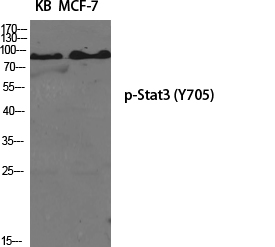
| WB | 1/500-1/1000 | Human,Mouse,Rat |
| IF | 1/20 | Human,Mouse,Rat |
| IHC | 1/50-1/100 | Human,Mouse,Rat |
| ICC | 1/50-1/200 | Human,Mouse,Rat |
| FCM | 咨询技术 | Human,Mouse,Rat |
| Elisa | 1/10000 | Human,Mouse,Rat |
| Aliases | STAT3; APRF; Signal transducer and activator of transcription 3; Acute-phase response factor |
| Entrez GeneID | 6774 |
| WB Predicted band size | Calculated MW: 88 kDa; Observed MW: 88 kDa |
| Host/Isotype | Rabbit IgG |
| Antibody Type | Primary antibody |
| Storage | Store at 4°C short term. Aliquot and store at -20°C long term. Avoid freeze/thaw cycles. |
| Species Reactivity | Human,Mouse,Rat |
| Immunogen | The antiserum was produced against synthesized peptide derived from human STAT3 around the phosphorylation site of Tyr705. AA range:672-721 |
| Formulation | Purified antibody in PBS with 0.05% sodium azide,0.5%BSA and 50% glycerol. |
+ +
以下是关于Phospho-STAT3 (Tyr705)抗体的3篇经典文献及其摘要概括:
1. **"STATs and gene regulation"**
- **作者**: Darnell JE et al.
- **摘要**: 该综述系统阐述了STAT蛋白家族(包括STAT3)在信号转导中的核心作用,强调Tyr705磷酸化是STAT3激活的关键步骤,并讨论了其抗体在检测DNA结合活性及核转位中的应用。
2. **"Stat3: a STAT family member activated by tyrosine phosphorylation in response to epidermal growth factor and interleukin-6"**
- **作者**: Bromberg JF et al.
- **摘要**: 研究证实IL-6等细胞因子通过JAK激酶诱导STAT3 Tyr705位点磷酸化,激活下游靶基因;利用Phospho-STAT3 (Tyr705)抗体验证了其在肿瘤发生中的持续激活机制。
3. **"IL-6 promotes tumorigenesis by modulating STAT3 oncogenic function in cancer stem cells"**
- **作者**: Yu H et al.
- **摘要**: 通过Phospho-STAT3 (Tyr705)抗体的Western blot和免疫组化分析,揭示了IL-6通过Tyr705磷酸化驱动STAT3在肿瘤干细胞中的异常激活,促进肿瘤生长和耐药性。
4. **"Signal transducer and activator of transcription 3 (STAT3) activation in heart failure"**
- **作者**: Haghikia A et al.
- **摘要**: 利用该抗体检测心肌纤维化模型中STAT3的Tyr705磷酸化水平,证实其在心脏应激反应中的双重调控作用,为靶向STAT3的治疗策略提供依据。
这些文献涵盖了该抗体在癌症、干细胞及心血管疾病研究中的关键应用场景。
The Phospho-STAT3 (Tyr705) antibody is a critical tool for studying the activation status of Signal Transducer and Activator of Transcription 3 (STAT3), a transcription factor involved in cell proliferation, survival, and immune responses. STAT3 is activated via tyrosine phosphorylation, primarily at residue Tyr705. which occurs in response to cytokines, growth factors (e.g., IL-6. EGF), or oncogenic signals. Upon phosphorylation, STAT3 dimerizes, translocates to the nucleus, and regulates genes linked to inflammation, cancer progression, and apoptosis. Dysregulated STAT3 activity, particularly hyperphosphorylation at Tyr705. is associated with numerous cancers, autoimmune disorders, and inflammatory diseases, making this modification a key biomarker for pathological states.
Phospho-STAT3 (Tyr705) antibodies are widely used in techniques like Western blotting, immunohistochemistry, and flow cytometry to detect activated STAT3 in cell lysates, tissues, or clinical samples. These antibodies specifically recognize the phosphorylated Tyr705 epitope, distinguishing active STAT3 from its inactive form. Researchers employ them to investigate signaling pathways (e.g., JAK-STAT), evaluate therapeutic inhibitors targeting STAT3 activation, or correlate phospho-STAT3 levels with disease outcomes. Validation of these antibodies is crucial, as off-target binding or cross-reactivity with other phosphorylated STAT family members may lead to inaccurate interpretations. Overall, this antibody is indispensable for mechanistic studies and translational research in oncology, immunology, and drug development.
×